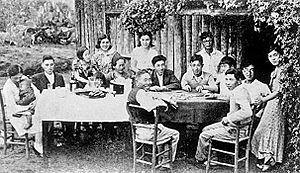Gosei (fifth-generation Nikkei) facts for kids
- For other uses, see Gosei.
Gosei (五世, literally, "fifth generation") is a Japanese language term. It means "fifth generation." This word is used in countries like North America and South America. It describes the children born to Japanese people who moved there.
The first generation of Japanese immigrants, born in Japan, are called Issei. Their children, born in the new country, are called Nisei (second generation). The grandchildren of the Issei are called Sansei (third generation). Their great-grandchildren are called Yonsei. The Gosei are the children of the Yonsei. This means Gosei are the great-great-grandchildren of the original Issei ancestors.
The Gosei generation has its own special history and characteristics. Experts in the United States and Japan are still studying them.
Contents
History of Japanese Immigration
The first organized group of Japanese people to move abroad settled in Mexico in 1897.
Later, in 1908, Japanese people began moving to Brazil. Today, the community of Japanese descendants in Brazil is very large. It includes about 1.5 million Brazilians. This makes it the biggest Japanese population outside of Japan. Other Yonsei communities also grew in the United States.
The word Gosei was created based on how the term Issei was used. In the 1930s, Issei became a common word. It replaced the general term "immigrant." This change showed how the Issei started to see themselves. It meant they felt they belonged to their new country.
Cultural Identity
The term Nikkei (日系) was created by experts in the late 1900s. Nikkei includes all Japanese immigrants and their descendants around the world.
The Issei were born in Japan. Their culture was mostly Japanese, even though they chose to live in another country. Their Gosei great-great-grandchildren grew up with a different national and cultural view. This view was different from their ancestors.
The Issei kept an emotional connection to Japan. But they built their homes far away from Japan. The Gosei have only known the country where they were born. They have never lived in Japan.
| Generation | What it means |
|---|---|
| Issei (一世) | People born in Japan who moved to another country. |
| Nisei (二世) | People born outside Japan to at least one Issei parent. |
| Sansei (三世) | People born to at least one Nisei parent. |
| Yonsei (四世) | People born to at least one Sansei parent. |
| Gosei (五世) | People born to at least one Yonsei parent. |
Each generation, from Issei to Gosei, has different views. These differences can be seen in how they view authority, gender roles, and religious practices.
The specific histories of Japanese immigrants in different countries also shaped the Gosei there.
Gosei in Brazil
Japanese-Brazilian (Nipo-brasileiro) Gosei are a small part of an ethnic group in Brazil. In 1990, less than 1% of the Japanese-Brazilian community were Gosei.
Gosei in the United States
The lives of Japanese-Americans from earlier generations are different from the Gosei. This is because Gosei often have English-speaking grandparents. A writer in 2011 said that "Younger Japanese Americans are more culturally American than Japanese." They also noted that a Yonsei or Gosei is "simply another American."


